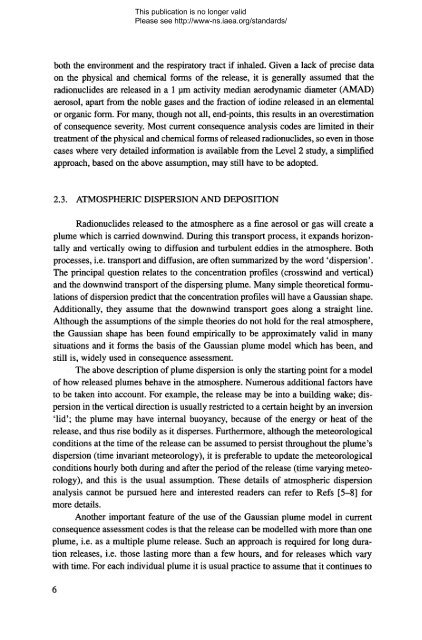LEVEL 3 - gnssn - International Atomic Energy Agency
LEVEL 3 - gnssn - International Atomic Energy Agency
LEVEL 3 - gnssn - International Atomic Energy Agency
Create successful ePaper yourself
Turn your PDF publications into a flip-book with our unique Google optimized e-Paper software.
This publication is no longer valid<br />
Please see http://www-ns.iaea.org/standards/<br />
both the environment and the respiratory tract if inhaled. Given a lack of precise data<br />
on the physical and chemical forms of the release, it is generally assumed that the<br />
radionuclides are released in a 1 pm activity median aerodynamic diameter (AMAD)<br />
aerosol, apart from the noble gases and the fraction of iodine released in an elemental<br />
or organic form. For many, though not all, end-points, this results in an overestimation<br />
of consequence severity. Most current consequence analysis codes are limited in their<br />
treatment of the physical and chemical forms of released radionuclides, so even in those<br />
cases where very detailed information is available from the Level 2 study, a simplified<br />
approach, based on the above assumption, may still have to be adopted.<br />
2.3. ATMOSPHERIC DISPERSION AND DEPOSITION<br />
Radionuclides released to the atmosphere as a fine aerosol or gas will create a<br />
plume which is carried downwind. During this transport process, it expands horizontally<br />
and vertically owing to diffusion and turbulent eddies in the atmosphere. Both<br />
processes, i.e. transport and diffusion, are often summarized by the word ‘dispersion’.<br />
The principal question relates to the concentration profiles (crosswind and vertical)<br />
and the downwind transport of the dispersing plume. Many simple theoretical formulations<br />
of dispersion predict that the concentration profiles will have a Gaussian shape.<br />
Additionally, they assume that the downwind transport goes along a straight line.<br />
Although the assumptions of the simple theories do not hold for the real atmosphere,<br />
the Gaussian shape has been found empirically to be approximately valid in many<br />
situations and it forms the basis of the Gaussian plume model which has been, and<br />
still is, widely used in consequence assessment.<br />
The above description of plume dispersion is only the starting point for a model<br />
of how released plumes behave in the atmosphere. Numerous additional factors have<br />
to be taken into account. For example, the release may be into a building wake; dispersion<br />
in the vertical direction is usually restricted to a certain height by an inversion<br />
‘lid’; the plume may have internal buoyancy, because of the energy or heat of the<br />
release, and thus rise bodily as it disperses. Furthermore, although the meteorological<br />
conditions at the time of the release can be assumed to persist throughout the plume’s<br />
dispersion (time invariant meteorology), it is preferable to update the meteorological<br />
conditions hourly both during and after the period of the release (time varying meteorology),<br />
and this is the usual assumption. These details of atmospheric dispersion<br />
analysis cannot be pursued here and interested readers can refer to Refs [5-8] for<br />
more details.<br />
Another important feature of the use of the Gaussian plume model in current<br />
consequence assessment codes is that the release can be modelled with more than one<br />
plume, i.e. as a multiple plume release. Such an approach is required for long duration<br />
releases, i.e. those lasting more than a few hours, and for releases which vary<br />
with time. For each individual plume it is usual practice to assume that it continues to<br />
6

















